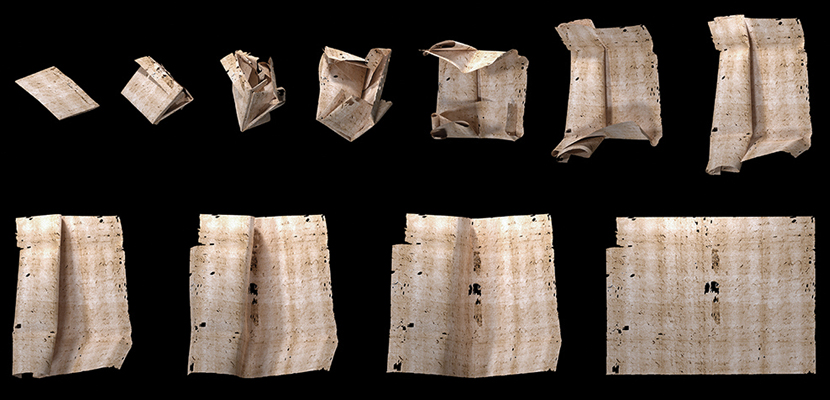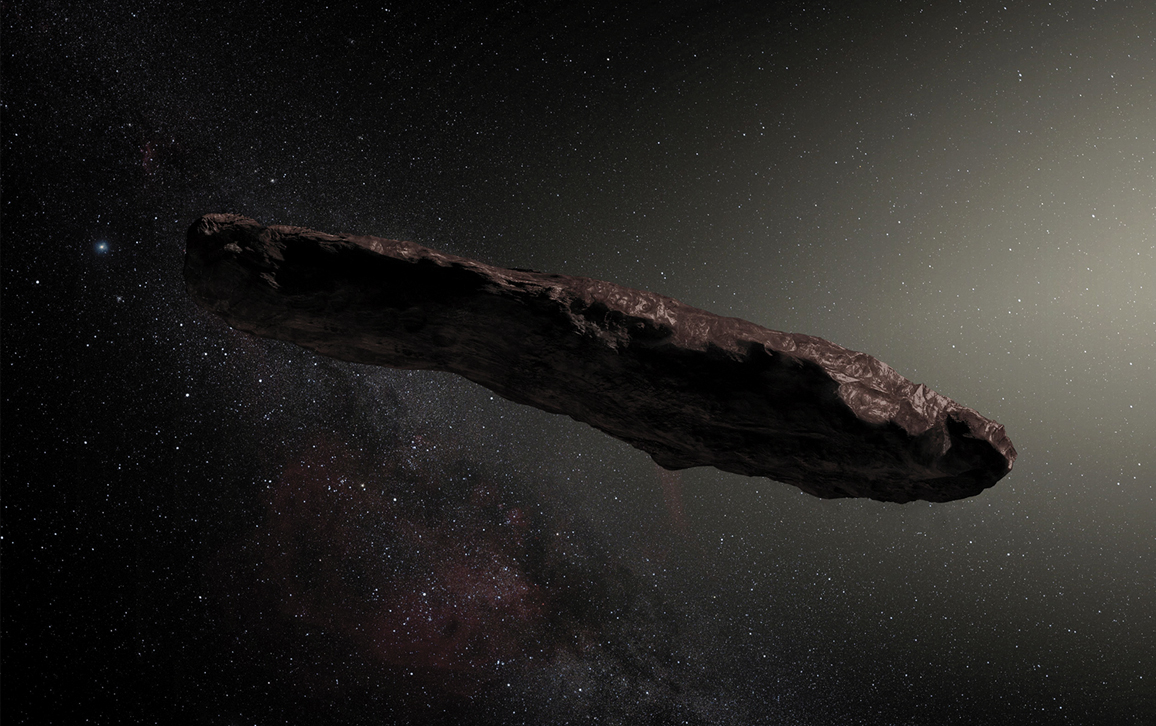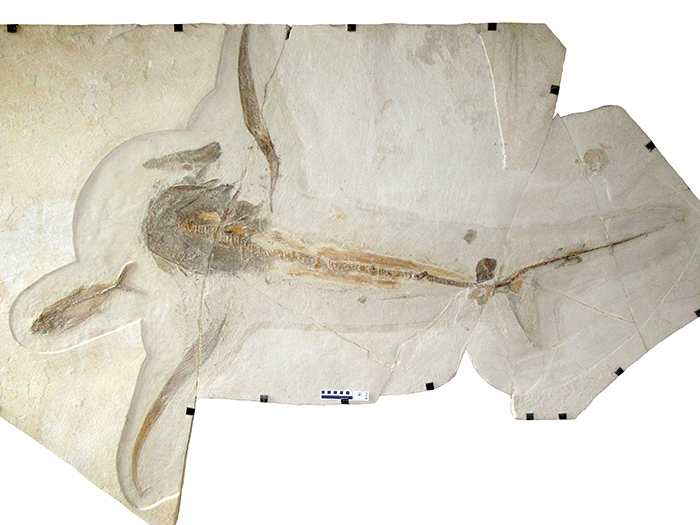
This Article From Issue
May-June 2021
Volume 109, Number 3
Page 142
In this roundup, managing editor Stacey Lutkoski summarizes notable recent developments in scientific research, selected from reports compiled in the free electronic newsletter Sigma Xi SmartBrief.
Opening 17th-Century Mail
Intricately folded Renaissance letters can now be read without damaging their delicate paper. A team of computer scientists, historians, conservationists, and dentists—yep, dentists—pooled their skills to develop an automated computational approach to uncovering the secrets in these messages. Before the invention of modern, self-sealing envelopes, correspondents kept their messages private with letterlocking, a complicated folding technique.

Image from Dambrogio, J., et al. CC-BY-NC 4.0
The researchers used x-ray microtomography—a method used in dental research to examine cross-sections of teeth—to analyze the folded layers of paper; the technology also picks up ink on the paper. The team used these x-ray images to create 3D digital reconstructions of the letters, which a computational algorithm then unfolded. The researchers tested the technique on items from the Brienne Collection, a 17th-century Dutch postmaster’s trunk containing more than 3,000 undelivered letters. Reading these letters will help inform our understanding of the everyday lives of people in Renaissance Europe.
Dambrogio, J., et al. Unlocking history through automated virtual unfolding of sealed documents imaged by X-ray microtomography. Nature Communications doi: 10.1038/s41467-021-21326-w (March 2).
Interstellar Nitrogen Iceberg?
The interstellar object ʻOumuamua has puzzled astronomers since its discovery in 2017 because it was observed accelerating away from the Sun like a comet, but astronomers didn’t see any evidence of outgassing that would explain the increasing speed. This mystery even led to speculation by some that the object could be alien technology. In a pair of papers in the Journal of Geophysical Research: Planets, astronomers Alan P. Jackson and Steven J. Desch of Arizona State University present some more plausible explanations for ʻOumuamua’s oddities.

CC-SA 4.0
They tested a variety of ices to see which would give the object the right albedo (the fraction of sunlight reflected back into space), and settled on nitrogen ice as the most likely candidate. ʻOumuamua’s albedo is similar to that of Pluto and of Neptune’s moon Triton, both of which are covered in nitrogen ice. Furthermore, the evaporation of nitrogen ice would give the object a push, explaining its acceleration. Jackson and Desch suspect that ʻOumuamua is a chunk that broke off of an exo-Pluto (a Pluto-like planet outside of our Solar System) and was propelled through space by a gravitational disruption in its home system. A similar event occurred in our Solar System billions of years ago, when Neptune’s migration caused collisions and the ejection of the majority of the Kuiper Belt’s mass.
Jackson, A. P., and S. J. Desch. 1I/ʻOumuamua as an N2 ice fragment of an exo-Pluto surface: I. Size and compositional constraints. Journal of Geophysical Research: Planets doi: 10.1029/2020JE006706 (March 16).
Desch, S. J., and A. P. Jackson. 1I/ʻOumuamua as an N2 ice fragment of an exo-Pluto surface II: Generation of N2 ice fragments and the origin of ʻOumuamua. Journal of Geophysical Research: Planets doi: 10.1029/2020JE006807 (March 16).
Fingerprints Are Hypersensitive
The patterns on fingers are good for more than deducing whodunit. We have long known that fingers are sensitive, and a team of Swedish physiologists has discovered that much of that sensitivity is concentrated in the ridges of fingerprints. The researchers ran a series of raised dots over participants’ fingers and tracked the reactions of individual nerve cells. They found that the areas with highest sensitivity are about 0.4 millimeters wide—approximately the same width as a fingerprint ridge. The topographies of these sensitive regions were consistent regardless of the speed or direction from which the raised dots passed over the participants’ fingers, and they followed the same unique pattern as their fingerprints. The high level of precision in our fingers for recognizing and spatially locating touch may help explain in part why humans are so dexterous.
Jarocka, E., J. A. Pruszynski, and R. S. Johansson. Human touch receptors are sensitive to spatial details on the scale of single fingerprint ridges. Journal of Neuroscience doi: 10.1523/JNEUROSCI.1716-20.2021 (March 15).
Prehistoric Shark Had “Wings”
Paleontologists have discovered a Late Cretaceous shark fossil with features similar to those of a manta ray. The many species of modern sharks found in marine ecosystems worldwide share a common form: streamlined bodies with long tails used to propel themselves forward. This new fossil species, Aquilolamna milarcae, had sharks’ characteristic strong tail, but it also had a 190-centimeter pectoral fin span, making the animal wider than it was long.

Wolfgang Stinnesbeck
A. milarcae shares other features with manta rays, including a mouth that is better suited for filter feeding on plankton than for predation. The fossil may be an example of convergent evolution, and it indicates that despite the narrow range of body types in modern sharks, their evolutionary ancestors did experiment with a variety of forms.
Vullo, R., E. Frey, C. Ifrim, M. A. González González, E. S. Stinnesbeck, and W. Stinnesbeck. Manta-like planktivorous sharks in Late Cretaceous oceans. Science doi: 10.1126/science.abc1490 (March 19).

American Scientist Comments and Discussion
To discuss our articles or comment on them, please share them and tag American Scientist on social media platforms. Here are links to our profiles on Twitter, Facebook, and LinkedIn.
If we re-share your post, we will moderate comments/discussion following our comments policy.